III ANATOMY AND PHYSIOLOGY OF THE HUMAN
- 1 MUSCULOSKELETAL SYSTEM
- 1.1 BONES
- 1.2 SKELETON STRUCTURE
- 1.3 MUSCULATURE
- EXERCISES AND TASKS
- Definition: An organ is a part of the body.
- Comparison with the definition:
- The general definition of the organ is also true for the muscle. So can we say, that the muscle.....
- 2. DIGESTIVE SYSTEM
- 2.1 INTRODUCTION TO METABOLISM AND ENERGY EXCHANGE
- 2.2 COMPONENTS OF OUR FOOD
- 2.3 ENZYMES
- 2.4 STRUCTURE OF THE HUMAN DIGESTIVE SYSTEM
- the admission of food and its transportation in the digestive canal, the physical comminution of food;
- the chemical dismantling of the big nutrient molecules into the particles (the real digestion);
- the admission of the digested substances in the cells of the intestinal wall.
- 2.5 WORK OF THE DIGESTIVE ORGANS
- EXERCISES AND TASKS
- 3. RESPIRATORY SYSTEM
- admission of air and its transportation intoto the lungs;
- admission of oxygen and delivery of carbon dioxide in the epithelium of the lungs;
- transportation of respiratory gases in the blood and the gas exchange in tissues;
- biological oxidation.
- 3.1 ORGANS OF THE RESPIRATORY SYSTEM
- 3.2 BREATH MOVEMENTS
- 3.3 GAS EXCHANGE
- 3.4 TRANSPORTATION OF RESPIRATORY GASES IN BLOOD
- 3.5 DISEASES OF THE RESPIRATORY SYSTEM ORGANS
- EXERCISES AND TASKS
- 4. CIRCULATORY SYSTEM
- 4.1 BLOOD VESSELS
- 4.2 BLOOD CIRCULATION
- 4.3 HEART
- 4.4 BLOOD AND LYMPH
- 4.5 DISEASES OF THE CIRCULATORY SYSTEM
- not enough movement,
- too much food, particularly too much fat,
- not enough sleep and unfavorable day division,
- too high consumption of cigarettes and other luxuries which contain poisons for the circulation.
- EXERCISES AND TASKS
- 5. EXCRETORY SYSTEM
- 5.1 FUNCTIONS OF THE EXCRETORY SYSTEM
- 5.2 KIDNEYS
- 5.3 UROPOIESIS
- EXERCISES AND TASKS
- 6. NERVOUS SYSTEM
- central nervous system, which consists of brain and spinal cord,
- peripheral nervous system: nerves going from the central nervous system and returning to it.
- 6.1 PERIPHERAL NERVOUS SYSTEM
- 6.2 VEGETATIVE NERVOUS SYSTEM
- 6.3 FUNCTIONING OF THE NERVOUS SYSTEM
- EXERCISES AND TASKS
- What does the grey substance of the brain or the spinal cord consist of?
Human can move due to the cooperation of bones and muscles. The bones of the body together with cartilages form the skeleton. Movable and hard union of bones belongs to the skeleton. All skeletal muscles form the skeletal musculature.
Bones are the support of the body. They form hard levers for the beginning of the muscles. They also protect softy tissues which lie under or in the bone.
Bones have different functions and different forms. Bones of the arms and legs are long, bones of the head are level and wide, bones of the hands and feet are short.
Structure of bones
The living bone consists of 3 parts: periosteum, bone substance and marrow.
Periosteum is outside. It surrounds the bone, but not the ends of the bone. It is built up from taut connective tissue, blood vessels and nerves.
Bone substance consists of bone tissue, blood vessels and nerves. If a bone is cut along, it can be seen that bone substance consists of 2 layers: compact substance lies outside and spongy substance under it.
Ccompact substance consists of bone tissue and is especially thick in long bones of arms and legs. It forms a hard tube with these bones.
Spongy substance consists of bone tissue which surrounds small hollow cavities. In these hollow cavities of spongy substance there is red marrow, a connective tissue which forms the red cells for the blood. Yellow marrow in the big, long hollow cavity of long bones is a fatty tissue.
Growth and development of the bones
All bones of our body are formed during their development from the connective tissue of the embryo. The bones of a young person do not grow up from the bone tissue because the developed bone cells cannot divide. The thichness growth of a bone takes place in the lower layer of periosteum and the length growth of a long bone in it ends where layers from cells can divide. The growth of the human is finished possibly by 23 years old because the cell layers stops in length growth forming new cells. When we get old, the amount of the yellow marrow grows. Moreover, the amount of the calcium salts grows in the bone tissue.
Connection of the bones
The connection of bones can be hard or movable. The example of hard connections is the bones of head. The movable connection is called a joint.
The joints can be found between the bones of arms and legs. The friction of bones in the joint is reduced by cartilage at the bone ends and liquid between these bone ends.

3.1 Structure of a long bone
1- periosteum, 2 - compact substance,
3 - marrow, 4 - spongy substance,
5 - cartilage

3.2 Joint
Human skeleton consists of about 223 bones, cartilage and connective tissue.
Skeleton is divided into the axial skeleton and the appendicular skeleton.
The axial skeleton consists of the skull (1), the backbone and the chest (3). The skull is the head of skeleton. The back part of the skull has the form of a ball. It protects the brain and is called brain skull. The front part of the head is called face. In the facial skull there are the hollow cavities which protect the senses and the mouth.
The backbone is the axis of the body. It consist of (32 to 34) vertebrae which are connected by cartilage discs. The vertebrae are bones give harness to the backbone. With the help of the discs from cartilage tissue we can bend the backbone. Every vertebra has processes to which muscles are fastened. The vertebrae form a tube in which the spinal cord lies protected.
All animals that have the backbone belong to the vertebrates. In the human body the backbone has several curves. They help people to walk straight. The curves originate when a child learns to run.
The chest consists of 12 dorsal vertebrae, 12 pair of ribs (4) and the breastbone (5). All ribs are connected flexibly with the backbone. Most ribs are connected in front by cartilage with the breastbone. The space of the chest can be increased by this kind of the connection with the respiration and be reduced. The chest protects lungs and heart.
The appendicular skeleton consists not only of the skeleton of the arms and the legs, but also of bones which join the limbs and the axial skeleton. The bones which connect the arm skeletons flexibly with the chest are together called the shoulder belt (6). With the help of the shoulder belt the arms are especially movable. The pelvic belt (8) fastens the leg skeletons hardly to the lower part of the backbone, so that the body can be well carried.
The skeletons of the arms and legs are built alike. The arm skeleton consists of an upper arm bone (7), two forearm bones (9) and the bones of the hand (10). In every hand there are five fingers (11).
The upper limbs have very movable joints, so that they can serve the human for the work.
The leg skeleton consists of a femur (12), two lower leg bones (14) and the bones of the foot (15). Each foot has five toes (16). The bones and joints of the leg skeleton are compact, so they can carry the body.
The shoulder joint is located between the shoulder belt and the upper arm bone. The elbow joint is between the upper arm bone and the forearm bones. It is followed by the wrist.
The knee joint is between the femur and the front lower leg bone. It is protected by the kneecap (13). It is followed by the foot joint.

3.3 Human skeleton
Structure of the skeletal muscle
The muscles of the skeletal musculature have cross-striped muscular tissue as an active component. There are muscle fibres which contain contracting myofibrils. Nerves and blood vessels lay between the muscles fibres. The muscle fibres lie in parallel and forma muscle which is surrounded by a connective-tissue cover. This muscle cover continues at the ends of the muscle in the tendons which fasten the muscle to the bones.

3.4 Structure of the skeletal muscle
The movements of skeleton are caused by the activity of the muscles which co-operate with the skeleton. Most skeletal muscles are fastened at their ends to two different bones. Both bones are connected by a joint.
If the flexor on the front side of the upper arm contracts, its tendon pulls the forearm at the upper arm: a person bends the arm.
At the same time with the contraction of the flexor the extensor, which lies on the rear side of the upper arm, it gets loose.
If the extensor contracts, it pulls back forearm in the stretched position with concurrent relaxation of the flexor. In this case oppositely active muscles are called antagonists. Other joints also have flexors and extensors.
If two or several muscles cause, however, the same movement, these muscles are called synergistic muscles. While lifting the arm forwards four muscles work together. Movements are caused generally in a single muscle.

3.5 Cooperation of muscles and bones

3.6 Antagonists in the upper arm
The work of the skeletal musculature is dependent on the tissues. By the nerves the muscular tissue receives stimuli from the brain or spinal cord. These stimuli cause a chemical process in the muscle cells when carbohydrate energy is released. With the help of this energy the myofibrils contract themselves.
Not only energy is generated from chemical processes in musculature, but also the warm energy, which has great importance for the body warmth, releases.
1. Answer the questions using the information from the text:
1. What does anatomy study?
2. What does physiology deal with?
3. What is a skeleton?
4. Which functions do the bones have?
5. What is a joint?
6. Which part of a bone can grow?
7. What two main parts is a skeleton divided into?
8. How is the axial skeleton divided?
9. What parts does the backbone consist of?
10. Which two parts are distinguished in the skull?
11. Which bones belong to the chest?
12. Which two bone belts do we have?
13. What is the muscle surrounded with?
14. Which function do the tendons have?
15. Where is the energy taken for the contraction of the myofibrils?
2. Use the missing names of the skeletal parts in the arrangement!
Skeleton: axial skeleton
………….….
Axial skeleton: skull (brain skull and ………………)
.…… (vertebra and ……………...)
……. (12 dorsal vertebrae, 12 pairs ……………
and ………………...)
Appendicular skeleton: shoulder belt
……………….
……………….
……………….
Arm skeleton: one ……………………
two ……………………
.………………………..
…………………….: one upper arm bone……………….
two …..………………….
……….………………….
3. How is a muscle built up? Read the text part again and underline the words which are important for the answer. Use the following verbs to describe the anatomical construction of the muscle: consists of, join, surround, continue, fasten.
4. Is a muscle an organ? Explain your answer.
It performs.....
It consits of.....
A skeletal muscle has a certain form.
It has the function.....
It consists of the following tissues:.....
The tissues of the body change constantly. The body needs building substances to construct its cells and intercellular substances. Biochemical metabolism, i.e. the process which serves for the construction of the body components, is called assimilation.
During assimilation the body components are built up from consumed substances alien to body. Thus, if we have eaten beef, the protein which is contained in this meat is alien to the body. It changes and then assimilates to the body in our cells with the help of the ribosomes.
For the life processes, for example movement, irritant admission, work of the brain, assimilation, the body needs energy. It gets this energy if it diminishes the big, high-energy molecules of consumed nutrients to small, low-energy molecules. The nutrients are called energy source. Their chemical energy is transformed, e.g., in kinetic energy or warm energy. The forms of energy are changed in the body, energy exchange takes place. The biochemical processes with which high-energy substances are diminished are called dissimilation. Energy is obtained through dissimilation.
Metabolism is connected with energy change. Both are necessary for all the life processes.
The body consumes firm and liquid substances as food. Every day we must consume substances of vital importance. This is an important condition for us to be healthy.
All firm and liquid substances which the body must consume are called food. Examples of food are rice, meat, milk, vegetables.
Components of our food
Food
Food stuff Gourmet food
![]()
![]()
![]()
![]()
![]()
![]() Nutrients Supplement substances
Nutrients Supplement substances
Carbohydrate Fat Protein Water Vitamins Mineral
substances
Nutrients and supplement substances must be present in the animal food, e.g. cattle.
The main functions of our food components in the body and its occurence in the food
|
Component |
Main function |
Occurence |
|
Carbohydrate |
Energy source |
Bread, rice, potatoes |
|
Fat |
Energy source |
Butter, oil |
|
Protein |
Building substances |
Meat, milk, eggs |
|
Water |
Building substances, transportation |
Milk, fruit, vegetables |
|
Vitamins
|
Important for metabolism and energy exchange |
Fruit, vegetables, meat, butter |
|
Mineral substances
|
Building substances (Ca in the bone tissue, Fe in blood) |
almost in all food |
The nutrients
The nutrients are organic compounds. The carbohydrates consist of the following elements: carbon (C), hydrogen (H) and oxygen (0). The carbohydrates are divided into three groups: monosaccharides, disaccharides and polysaccharides. Monosaccharides are the basis of disaccharides and polysaccharides.
Monosaccharides and disaccharides are present in fruit in particular. Starch is the main nutrient in potatoes, bread and rice. Glycogen is included in meat.
|
Groups |
Sum formula |
Examples |
|
Monosaccharide |
C6H12O6 |
glucose |
|
Disaccharide |
C12H22O11 |
maltose |
|
Polysaccharide |
(C6H10O5)n |
starch, glycogen, cellullose
|
Monosaccharides have small molecules and are water-dissolvable, so that they can be consumed by the cells of bowel and transported by blood to all cells of the body.
Disaccharides and polysaccharides have big molecules which must be diminished only into its basic elements, monosaccharides. Cellulose cannot be diminished by our body. It to the transport all substances to bowel. Glycogen is water-indissolvable, therefore, certain amounts of it can be stored, e.g., in muscle cells.
Fat consists of the same elements as carbohydrates, but the molecules have another structure. The body is able to transform fat into carbohydrates and carbohydrates into fat. The base of fat are glycerine and carboxylic acids. Every fat molecule contains a molecule of glycerine and three molecules of carboxylic acids which are connected.
Example of fat: (C17H35COO)3 · C3H5
Fat is energy sources, it can be stored in the bodyfor longer time. 1 gramme of fat gives 39 kJ energy. From the same amount of protein or carbohydrates only half of the energy can be received. If the body consumes too much fat, it stores it in the fatty tissue. As the body can transform glucose into fat, it also stores carbohydrates as fat. If the food does not include enough carbohydrates or fat, or if the body particularly needs a lot of energy needs, the body diminishes the stored fat and wins the energy contained in it.
Proteins also contain carbon, hydrogen and oxygen, nitrogen (N) and other elements. The basis of protein is amino acids in which the amino group (-NH2) is included.
Example of amino acid is (CFE2CNH2) · COOH
A protein molecule consists of many different amino acids which elaborately built protein molecules often with other connections. The body must consume amino acids daily, because it cannot build up the amino groups of the amino acids itself, and it cannot store protein. If the body, especially child’s body, does not get enough animal protein, protein deficiency illnesses appear. They still exist in many countries and are a cause of child mortality. These illnesses commonly appear in the poor population in capitalistic and a little developed countries.
Vitamins
Vitamins are organic substances which are built chemically very differently. They are denoted in alphabetic order, e.g., vitamin A, vitamin B1.
There are water-dissolvable vitamins and fat-soluble vitamins. They are of vital importance for all organisms because they are parts of enzymes which are used for metabolism reactions. Our body can build up vitamins not only from the elements. Vitamins or their provitamins must be consumed with food. The everyday need is low (only milligramme), but it must be consumed. Lack of certain vitamins cause illnesses.
Vitamin D is a fat-soluble vitamin. It is included, e.g., in fish, butter, milk and eggs. The provitamin are in our skin and are built up by sunlight to active vitamin D. It provides the admission of calcium connections from the food and gives firmness to the bone tissue.
Rachitis among small children is caused by lack of vitamin D. The bones of these ill children remain soft and bend. This illness appears in the countries in which the workers get not enough money to be able to nourish their families properly. Healthy eating, constant examination of all children by the doctors, medicine with vitamin D fight against the illness.
The main task of enzymes
Enzymes are proteins which work as biocatalysts. This means: a tiny amount of an enzyme influences the speed of chemical reactions in the metabolism.
Most metabolism reactions cannot run without enzymes with body temperature and normal pressure because the organic substances react under these conditions very slowly. Metabolism depends completely on the effect of enzymes.
A certain enzyme can influence only on one certain reaction of a certain material. For example, the enzyme maltase works only on the disaccharide maltose, and the enzyme lipase works only on fat.
The role of hydrolases in digestion
The nutrient molecules (fat, protein, polysaccharide) must be disassembled by digestion into their basic elements (glycerine, fatty acids, amino acids, monosaccharide) because only these smaller molecules can be taken up by the epithelium cells of stomach and bowel and transported in the body.
This splitting uses water. The digestive enzymes transfer water molecules into the big nutrient molecules. Such enzymes which split organic connections and transfer water molecules are generally called hydrolysis.
Dependence of enzyme effect from certain conditions
Every enzyme needs certain conditions for its optimum effectiveness. Some enzymes work only in acid envorinment, others only in alkaline environment. For example, the mouth amylase is effective only in the mouth alkaline envorinment, not in the stomach acid envorinment.
Formation and components of enzymes
All enzymes are formed in the living cells, and most of them work only in cells. The digestive enzymes are formed by glandular cells of mouth, stomach and other organs, but are delivered in the internal hollow cavities (oral cavity etc.). They work beyond the cells in the digestive canal.
Enzymes consist of proteins, which are connected with a special active group (often with a vitamin).
It has been found that different organisms with similar methabolism have similar enzymes. This shows that many parts of metabolism are basically similar in all organisms.
Research of enzymes depends on the development of complicated devices and measuring methods. It has been proved that all processes taking place in the organism are biochemical or biophysical. They are material. The scientists have recognised that to the explanation of the physiological processes in the organism unscientific images are unnecessary.
The scientific names of the enzymes
The names of the enzymes end in -ase. Protein is split into protease, maltase splits into maltose, lipase disassembles fat, amylase diminishes starch. The starch-splitting, protein-splitting, fat-splitting and maltose-splitting enzymes belong to the hydrolases.
The digestive system performs the following functions:
These processes are performed by different organs which form the digestive canal or are joined with this canal. The canal beginning is the mouth, the end is the anus.

3.7 Digestive organs
Tissues of the digestive canal
Sine all the walls of the digestive canal contain ring and longitudinal muscles from smooth muscular tissue, food can be transported and chopped up physically.
The chemical dismantling of the nutrients occurs with the help of enzymes which are formed by the digestive glands.
The digested substances are consumed by the epithelium tissue of the intestinal wall. Blood brings oxygen to the tissues of the digestive canal and transports carbon dioxide and the substances consumed by the epithelium cells. Nerves influence the activity of the digestive canal.
The small intestine. The first part of the small intestine (about 20 cm long) is called the duodenum. Two big glands deliver its secretion to the duodenum: the liver and the pancreas.
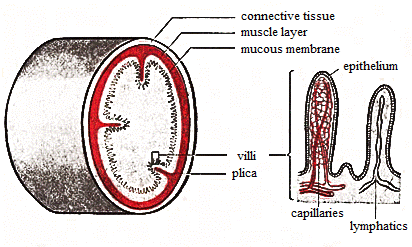
3.8. Small intestine (cross section) and two villi (cut)
The liver is the biggest gland of our body. The secretion delivered by it, the bilious juice, is stored in the gall bladder. The bilious juice is delivered to the duodenum when it is used there.
The pancreas is located under the stomach and delivers the pancreas juice to the duodenum as a secretion.
The walls of the duodenum and the remaining small intestine contain the millions small glands which excrete the intestinal juice. In the small intestine the chemical digestion is finished.
The internal surface of the small intestine is strongly increased by folds and villi. Villi are inly 1 millimetre high and sit on the ring-shaped folds. By the enlarged surface it is possible to deliver more secretion and to consume more digested substances in the intestinal epithelium.
The large intestine. This part of bowel begins with the cecum with has a process. The mucous membrane of the large intestine has no villi and no digestive glands.
The epithelium of the large intestine consumes water from the remnants of food.
There originates the excrement in which there are many bacteria. It is stored until delivery which occurs through the anus in the last part of the large intestine. The ring muscle of the anus closes the digestive canal.
Physical comminution of the food
Hard food is chopped up in the oral cavity by the teeth. The surface of food parts is increased by this physical comminution, so that then the enzymes of the different digestive glands can reach possibly up to all nutrient molecules contained in food. The comminution is continued by the movements of the stomach and bowel. Besides, the nutrients are mixed with the enzymes.
Fat with body temperature is in the liquid state. But the big drops of the fat have too low surface for the effect of lipase. Therefore, the bilious acids contained in the bilious juice work in the small intestine. The big drops of fat are disassembled by the bilious acids physically, so that many smaller drops appear which together have bigger surface and hence, lipase has a stronger effect.
Chemical digestion of the nutrients
Amylase contained in the saliva breaks in the mouth into parts which contain starch in maltose. The remaining part of starch is swallowed undigested.
Certain glands of the stomach mucous membrane excrete protease, others form hydrochloric acid which makes protease effective. The protease splits the protein molecules in less long chains of amino acids, so-called polypeptide.
Amylase, maltase, protease and lipase are included in the pancreas juice and in the intestinal juice. They help the small intestine to split nutrients into monosaccharide, amino acids, glycerine and carboxylic acids.
Cellulose is not diminished by our enzymes, however, it stimulates the intestinal movement.
Resorption
The substances split chemically now can be consumed by the cell membrane of the intestinal epithelium in the intestinal mucous membrane. The admission of the digested substances is defined by the intestinal wall resorption. The absorbed substances, namely water, salts, monosaccharide and amino acids, are transmitted by the epithelium and connective tissue cells of villi in the small blood vessels of villi, but fat is taken by small lymphatic vessels.
1. Answer with the help of the text
1. What is assimilation? Find the detailed answer in the text.
2. How does our body get the energy of vital importance? What is dissimilation? Underline the definition in the text.
3. What is the difference between building substances and energy sources? Give examples.
4. Which substances are of vital importance? Which functions do they have in the body? Which substances don’t we need?
5. Which substances belong to nutrients? Which supplement substances must be contained in the food?
6. Which elements do the nutrients consist of?
7. What is starch? In which food is it the main nutrient?
8. Which group of chemical substances do enzymes belong to?
9. Why must the nutrients be digested?
10. How do hydrolase work?
11. What is protease?
12. What is digestion?
13. What does the canal for the digestion begin with? What does it end with?
14. Which tissues are in the digestive organs?
15. Which functions does the tongue have?
16. Which secretion does the digestion begin by?
17. What is duodenum?
18. Where is the pancreas located?
19. How does protease of the gastric juice become effective?
20. What is resorption? Give a definition.
2. Explain the terms. Give examples for these terms
1. Food, food stuff, nutrient
2. Carbon, сarbon hydrate, carbon dioxide
3. Glucose, glycogen, glycerine
3. Complement the table: The segments of the digestive canal
|
Segment |
Anatomical clues |
Digestive glands |
Secretion |
|
Oral cavity |
Lips, teeth, tongue, masticatory |
3 pair of salivary glands, glands of the oral mucosa |
Saliva |
|
… |
|
|
|
The living cells of the organism are supplied with oxygen by the respiration, so that they can get energy from the organic substances.
Different processes belong to respiration:
The respiratory organs, such as the lungs, belong to the respiratory system. While inhaling, the air flows out by the nose or mouth, by the pharynx, the larynx, the windpipe and the bronchi up to the alveoli of the lungs. While exhaling, the same way is used in opposite direction. It is favourable if the clean, warm and humid air enters the lungs.
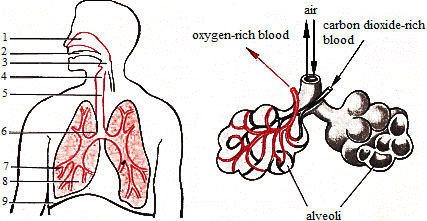
3.9 Organs of the respiratory system
1 – nasal cavity, 2 – oral cavity, 3 – pharynx, 4 – larynx, 5 – trachea, 6 – bronchi,
7 – branching of bronchial tubes, 8 – alveoli and blood vessels, 9 – diaphragm
The nose is divided by a wall into two caves. In the nasal cavities the air is cleaned by the fact that hair and a humid mucous membrane holds on the dust. The breath air is warmed up, while it consumes warmth of the numerous blood vessels in the nasal mucous membrane. Moreover, the dry breath air is moistened by the secretion of the mucous membrane. The smelling epithelium checks the air for its smell.
By the pharynx the air flows out to the larynx. It consists primarily of cartilages, located in front of the throat. With the breathing the larynx opens, but with the gulp of saliva or food it closes.
Windpipe, located in the throat and cavity of chest before the esophagus, is divided at the lower end into two bronchi which branch out in the lungs. The dust which is still present in the inhaled air, can be transported by the epithelium of the windpipe and the bronchi outwards.
The lungs fill the biggest part of cavity of chest. They are fastened by membranes in the inner wall of the cavity of chest and lie on the diaphragm. The diaphragm is a muscle disk between the cavity of chest and the abdominal cavity. The bronchi branching out in the lungs ends with elastic alveoli which are surrounded by blood capillaries. The surface of the lungs is strongly increased by the number of the alveoli (from about 500 to 700 million). The lung surface is about 50 times bigger than the body surface. As the alveoli consist of humid, single layer epithelium, the gas exchange is slightly possible between the alveoli and the capillaries.
The breath muscles are stimulated by the irritation which comes from the brain and forces the breath muscles to contract. The lungs have no muscles. The breath movements are caused by muscles between the ribs and by the diaphragm. The lungs carry out the movements passively. If the amount of the carbon dioxide grows in the blood to a certain value, this excitation stimulates the contraction of the breath muscles. If the interrib muscles contract themselves, the chest is lifted forwards and up because the ribs are fastened by joints to the backbone.
At the same time the diaphragm contracts itself and thereby falls. The chest together with the lung space is increased by both changes. As a result of this enlargement of the breast space, suppressing originates in the lungs. The air from the environment on the breath streams into the lungs. This process is called inhale. The stronger the contractions of the breath muscles, the greater aerial amount is.
If the breath muscles, which contracted themselves while inhaling, weaken, the chest is lowered and the diaphragm is lifted. The result is the reduction of the breast space. Overpressure originates in the lungs from it. This overpressure entails the exhaust of the air on the breath. This process is called exhale.
About 500 cm3 of the air is changed with quiet respiration, but from 3000 to 4000 cm3 of the air with maximum respiration. The greater the breast space is, the greater the amount of the changed air can be.

3.10 Inhale (a) аnd exhale (b)
The air of the environment contains about 21% of oxygen and about 0.03% of carbon dioxide, the exhaled air contains about 16% of oxygen and about 4% of carbon dioxide. Nitrogen in the air (about 78%) has no effect on respiration.
These respiratory gases are exchanged in the alveoli and in the body tissues by diffusion. The gas molecules move from the place of high concentration to the place of low concentration. The reason for the movement of gas molecules is their thermal movement. The diffusion is finished if a homogeneous mixture has formed, i.e. if pressure and concentrations of the gases have became the same.
The blood flows to the lungs under carbon dioxide pressure i.e. it has a relatively high carbon dioxide pressure, and it is low in oxygen, i.e. it has a relatively low oxygen pressure. The air in the alveoli, on the contrary, has a relatively high oxygen pressure and a relatively low carbon dioxide pressure. These pressure ratios and concentration relations are the cause for gas exchange. Thus, the oxygen gets into the blood and the carbon dioxide in the air of the alveoli. As exchanged gases are removed immediately with the blood or with the breath air, there are always concentration differences.
Gas exchange between the blood and tissues occurs if the blood rich in oxygen has flowed to tissues. Every living cell uses oxygen and forms carbon dioxide. Cells constantly need oxygen, they are low in oxygen. Their oxygen pressure is lower than the oxygen pressure in the blood which comes from lungs. Carbon dioxide has reverse pressure ratio. The result is that the carbon dioxide is leaked from the cells of tissues into the blood. From the body tissues the coming blood is low in oxygen and rich in carbon dioxide.
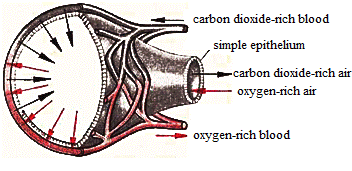
3.11 Gas exchange in an alveole
Oxygen gets into the blood by the humid epithelium of the alveoli. The blood consists of liquid and different kinds of cells. The liquid of the blood can take up only very little oxygen and advance because the pressure differences of oxygen are not big. However, the red cells, erythrocytes, own red colouring, hemoglobin which can bind the oxygen fast and in large quantities chemically. With relatively high oxygen pressure (in alveoli) hemoglobin oxygen takes up, and it delivers the oxygen again to relatively low oxygen pressure (in tissues). Erythrocytes are very small, and there are millions per cubic millimeter, so they have a very big surface (3600 m²), and a lot of oxygen (about 1 litre) can be transported in a bound form. The carbon dioxide is transported primarily as a HCO3-ion in the liquid of the blood and gets into by the humid epithelium of the air cells.
Diseases of the organs of the respiratory system are as follows: inflammations of the nasal cavities (cold), the pharynx, the bronchi (cough) or the lungs. With these diseases the mucous membranes become red and form a lot of mucus. It comes to pains and fever.
These diseases belong to the infection illnesses. They are caused by bacteria or viruses and are transferred by human to human. The lung tuberculosis originates from the fact that tuberculosis bacteria increase in the lungs strongly, inflammations can destroy parts of the lungs. Even today the lung tuberculosis is in many countries a frequent disease and a reason of death particularly among the population with bad living conditions. The lung tuberculosis can be recognised by X-ray examination and be healed by drugs, good food, warmth and air rich in oxygen.
Another disease is cancer. With cancer the metabolism and the tissues growth are strongly changed. It originates from cell increase, which grow and thicken. Numerous scientific investigations have proved that cancer can be caused in the organs of the respiratory system by smoking. Cancer belongs to the most frequent causes of people death.
Injurious bacteria and viruses can increase in a weak body strongly. This state originates, e.g., from bad food, lack of light, air and movement, sleep deprivation, worries, too high consumption of alcohol and tobacco.
Everybody must have regular examination and support healthy life-style.
1. Answer the questions using the information from the text.
1. Why must we breathe constantly?
2. Which organs form the respiratory system? How the respiratory organs are called?
3. What is the diaphragm?
4. What do the lungs consist of?
5. What is the antonym for ‘active’? Which organs carry out no active movements?
6. Which muscles cause the inhalation and exhalation?
7. Where are the respiratory gases exchanged?
8. Which biophysical process cause gas exchange?
9. What is diffusion?
10. Which qualities does the blood coming from the lungs have?
11. What are erythrocytes? What task do they have?
12. What importance does the hemoglobin have?
14. What is an infectious disease?
15. What is cancer? Where does cancer originate from in the organs of the respiratory system?
2. Describe the process of inhaling and exhaling
3. Explain why inhaling is more favourable by the nose than by the mouth?
4. In small groups discuss smoking. Gather information on this theme. Form an opinion to this problem and explain it academically
5. Discuss with your friends the need and the possibilities of keeping the organs of the respiratory system healthy. Consider how you can change your life-style to stay healthy.
The blood is the most important means of transportation for substances. It connects all tissues and provides the functional unity of the organism. On its way the blood constantly exchanges substances with tissues where it runs. The heart and the vessels are the organs of the circulatory system.
The human, as well as all the other vertebrates, owns a closed blood circulation, i.e. that the blood runs only in blood vessels and not freely between tissues. Blood vessels are called also veins. There are: arteries, veins and capillaries.
All blood vessels which lead the blood from the heart are called arteries. They are thickwalled and elastic. The wall of the arteries has a thick muscle layer. If this muscle layer weakens, more blood coming from the heart can be taken up. The blast running in the arteries is called pulse. The pulse can be felt and counted at the places at which the arteries lie close under the skin (beside the larynx, with the wrists). The arteries branch out in the body parts and organs in thin arteries and, finally, in microscopic thin capillaries.
The walls of the blood capillaries consist only of a single-layered surface epithelium through which metabolism occurs between the blood and tissues. If metabolism is favourable, then the whole internal surface of the capillaries is very big.
All blood vessels which lead there the blood from the heart are called veins. They have only one thin muscle layer, are thereby are less elastic and have a bigger internal diameter. The blood runs trough the veins slower than in the arteries, and it has a lower pressure. The blood running back in the capillaries is prevented by numerous vein flaps. They let the blood run only to the heart. Arteries and veins serve for the blood transport, but the capillaries mainly carry out the metabolism through their walls.
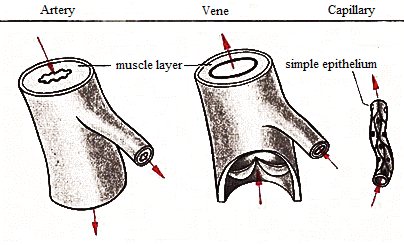
3.12 Types of blood vessels
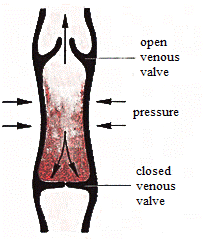
3.13 Approach of a vein
The blood circulation is divided into the body circulation and the lung circulation.
In the body circulation the blood is caused by the left half of the heart, the aorta, the biggest artery. It runs from there by arteries (e.g., head arteries, arm arteries, leg arteries, intestinal arteries) into the capillaries of the organs. With the blood running the tissues take necessary substances from the blood and deliver other substances in the blood. The blood from the capillaries unites in small and then in bigger veins (e.g., head veins, arm veins, leg veins, liver vein). Finally, the blood gathers in two hollow veins which push the blood back to the right half of the heart.
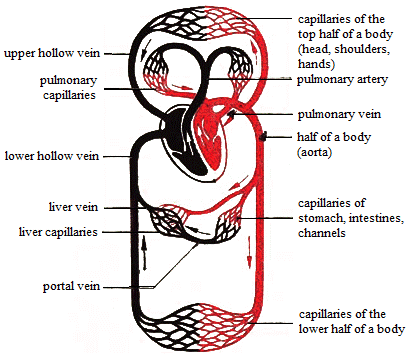
3.14 Blood circulation of the human
All capillaries of the stomach, pancreas and bowel unite to a special vein, the portal vein which pushes the blood rich in nutrient leads to the liver. There this vein branches out in liver capillaries. The blood which comes from the aorta is rich in oxygen and it also runs to the liver. The liver capillaries join the liver veins which lead to the lower hollow vein.
In the lungs blood circulation from the right half of the heart is pressed by the lung arteries and the lung capillaries. After gas exchange in the alveoli the blood gets back by the pulmonary veins to left half of the heart. The blood with low oxygen runs in the lung arteries, the blood rich in oxygen runs in the pulmonary veins.
The heart is divided by a wall into two halves. Every half consists of a forecourt and a chamber. The muscle layer of the left ventricle is thicker than the right, because the blood must be pumped into the vessels of the big body circulation from the left ventricle. There are heart flaps between precardium and chamber in every half as well as at the beginning of the aorta and the lung artery. They prevent the blood from running back.
The heart hits without our will. However, it can be influenced by other organs. If the body is in rest, one counts from 60 to 80 heartbeats a minute. The heart already works in embryo.
The blood always streams at the same time into two precardia. The forecourts contract themselves, and the blood is pressed by the open flaps in the chambers. Now the chambers contract themselves and press the blood at the same time in the aorta and the lung artery. The flaps thereby close the precardia and the folding aorta and the lung artery opens. The blood running back to the heart is prevented, while the flaps closet the beginning of the arteries. Now there is the heart pause. By the relaxation of the heart musculature the blood runs to precardia and the process recurs.
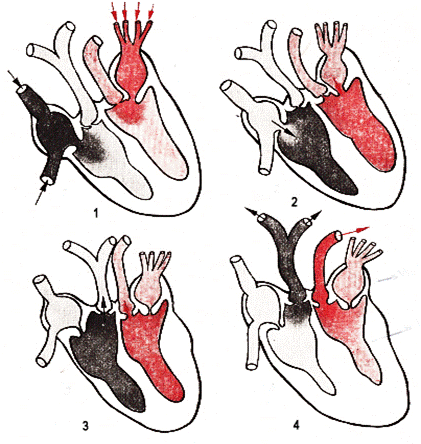
3.15 Description of heart work
5 to 6 litres of the blood run through the blood vessels of an adult, 55% of the blood are blood plasma, 45% are cells. The blood plasma consists primarily of water, protein, glucose, fat, salts and other substances. When the blood runs through the muscles or the internal organs, it gets warm and delivers warmth to the body surface again. The blood is not only a means of transportation, it also serves for the heat exchange.
There are three groups of blood cells: erythrocytes, leucocytes and thrombocytes.
Erythrocytes contain hemoglobin, a ferrous red colouring. As they exist very numerously, they give the colour to the blood. They are formed in the red marrow and are diminished in the liver.
Leucocytes, the white cells, destroy bacteria and injurious substances in the blood or in tissues. With infectious diseases, their number is growing higher.
Thrombocytes, the smallest cells of the blood, contain enzyme which causes the coagulation of the blood together with other substances. If there was a wound, the blood coagulates in a complicated process and closes them.
Lymph is a watery liquid which is formed in tissues and takes away injurious substances and bacteria from there. It gathers in lymphatic vessels which are built as the veins and runs through lymphatic knot. This thickening works like filter for injurious substances and bacteria. The lymphatic vessels join with veins in the thoracic cavity.
Lymph takes away fat from the villi of bowel, and thereby becomes a milky liquid at these places.
A constant metabolism takes place between the blood and lymph (e.g., water, dissolved substances, leucocytes).
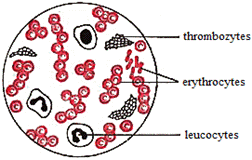
3.16 Human blood cells (microscopic picture)
In some countries the diseases of the circulatory system are at the moment the most frequent cause of death.
The causes are mostly mistakes in the life-style, e.g.:
As a result of wrong life-style the blood vessels change. Their internal diameter becomes smaller. If blood vessels are closed, tissues and organs cannot fulfil their functions any more, and it can result in human death. With a healthy life-style every human is able to prevent the diseases of the circulatory system.
1. Answer the questions using the information from the text.
1. What is a closed blood circulation?
2. What is a vein? Name different veins.
3. Which part of the blood circulation do the aorta, two hollow veins and the portal vein belong to? Where do they lie?
4. What is a pulse? Feel and count your pulse.
5. What is a blood plasma?
6. What does lymph look like?
7. Why is the blood red? Why can it flow not so fast as water?
8. What is a wound?
9. Which functions do the leucocytes have?
10. What are the causes of the blood system diseases? How it is possible to prevent these diseases?
2. How are the blood vessels called?
from the heart to the lungs …………………………
from the aorta to the head …………………………
from the aorta to the arms …………………………
from the liver to the lower hollow vein …………………………
from the bowel to the liver …………………………
from the legs to the lower hollow vein …………………………
from the head to the upper hollow vein …………………………
3. Use the suitable adjectives in the text
The blood is a tissue which intercellular substance contains a lot of water. Therefore, the blood is called ……………. tissue. The cells of the blood contain a lot of protein in comparison to the fat cells. These are …………………… cells.
The blood coming from the lungs takes oxygen and delivers carbon dioxide. It is ……………….. and ……………… The blood flowing out from the digestive canal takes protein and carbohydrates. The blood in the portal vein is ……………… and …………………, but ………………… The lymph coming from bowel is ……………… It mixes up with ……………… lymph running from other organs and joins the blood which runs to the heart.
4. Discuss with your friends how you can avoid mistake in the life-style to stay healthy.
The biochemical processes in the human body produce the substances which the body does not need any more and they even can be injurious to the body. These useless substances must be eliminated from the cells and tissues, from the body, otherwise they can lead to disturbances of the biochemical processes in the cells.
Excretory organs for substances which are not used any more are lungs, kidneys and skin. While the lungs eliminate carbodioxide and steam, the kidneys and the skin remove primarily water, urea and inorganic salts (especially cooking salt, sodium chloride).
You have already got to know the skin and the lungs.
The about 12 cm long kidneys of the human lie to both sides of the backbone above the pelvis. These organs are of vital importance. The kidneys eliminate injurious substances from the body, they regulate the water balance and the salt balance. The water balance of a living being is understood as admission, processing and delivery of the water.
The secretion of the kidneys is called urine. On daily basis more than 1 litre of urine is eliminated. The urine consists of water, urea as the most important waste product and small quantities of many other substances. The composition of the urine changes, it is dependent, e.g., on food, work and temperature. A human eliminates on the average about 30 g of urea during the day.
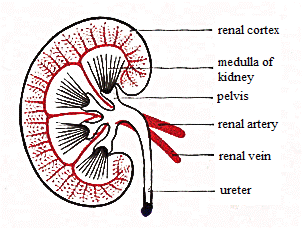
3.17 Kidney (profile)
The urea eliminated by the kidneys (CO(NH2)2) originates in the liver from the nitrogen-containing end product of the protein change, the toxic ammonia (NH3). By the excretory of superfluous water and salts the kidneys have an essential influence on the ion concentration in the blood and in the cells.

3.18 Nephritic corpuscles (strongly enlargedly)
The blood amount of the body runs every hour about 12 times through the kidneys. Uropoiesis occurs in about 100000 nephritic corpuscles and the little urinary canals. The nephritic corpuscles lie in the external layer of the kidney, the renal cortex. A nephritic corpuscle consists of capillaries which are surrounded by a capsule from simple epithelium. A filtrate of the blood liquid which consists of water and the substances dissolved in the blood liquid (e.g., glucose, cooking salt, urea) is eliminated in the capsule of the nephritic corpuscles from the capillaries. Proteins are held back in the blood.
The filtrate is changed on the way by the little urinary canals. The little urinary canals surrounded by blood vessels lie in the internal layer of the kidney and are called the nephritic marks. The epithelium of the little urinary canals takes water and important substances for the preservation of the body, e.g., glucose, from the filtrate again and returns them to the surrounding blood vessels. The urine gradually originates from filtrate rich in water of the nephritic corpuscles.

3.19. Uropoiesis
1. Answer the questions using the information from the text.
1. What organs belong to the excretory system?
2. Which substances are eliminated by these organs?
3. What is the water balance of a living being?
4. What is the difference between filter and filtrate?
5. Explain the nephritic activity with the example. Where does urea originate from?
7. What does urine consist of?
8. In which organ is urea formed? Which organ eliminates urea from the blood?
2. Complement the text with the following words: urine, uropoiesis, renal tubule, urea
…………………. is formed in the liver from the ammonia originating in the protein metabolism. ………………… occurs in the kidneys then. The renal corpuscles take the substances from the blood by which a part is delivered in …………………….. again in the blood. From these both processes …………………. originates
3. Describe the construction of the kidneys.
4. Describe the uropoiesis.
5. Explain why the kidneys are the organs of vital importance.
In the nervous system of the human two parts can be distinguished anatomically:
Accornding to the division by their functions, firstly the vegetative nervous system should be defined, it regulates the activity of the internal organs.
The soft tissues of the brain and the spinal cord are surrounded by bone, skull or backbone.
The nerve cells are primarily located in some areas of the central nervous system. They are called ‘grey substance’ due to their colour.
In other areas of the central nervous system run the long processes of the nerve cells. They are called ‘white substance’ because these areas look white. The processes go from the higher segments of the central nervous system to the deeper ones and, finally, to other organs or in reverse direction.
The spinal cord. The spinal cord is 40 to 45 cm long and 1 cm thick.
The cells of the grey substance lying inside of the spinal cord can produce connections between organs and form the basis for all reflexes which run in the spinal cord.
The spinal cord is linked with the brain by the nerves which go there and back and form the white substance of the spinal cord.
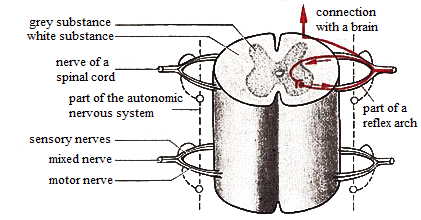
3.20 Spinal cord and its nerves
The brain. The human owns the most developed brain among all animals. The high effectiveness is caused not by the mass (on an average in 1350 g), but by the number of the nerve cells as well as the number and type of their connections.
Both halves of the cerebrum form the biggest part of the brain. Cerebrum and little brain form especially big surface. The other parts of the brain make up the brain stem.
The grey substance is located near the brain in the brain cortex. The white substance of the brain consists of nerves which pass irritation in the brain or to the spinal cord.
Regardless of our will, the processes running in the body are regulated, primarily, by the brain stem and the little brain: the functions of the internal organs, the hormone glands, the body temperature.
The brain cortex has to fulfil substantially more complicated duties. It is the higher centre. Deliberate movements, deliberate irritant admission and the thinking are possible by its effect.
The brain cortex works as a whole, its functions are the result of the cooperation of all its segments. However, there can be certain centres which are involved with certain functions (e.g., seeing, smelling, hearing, speech) mainly. These centres concern the groups of nerve cells in which the nerves coming from the sensory cells end, or groups of the nerve cells in which nerves serving the deliberate movements, begin. If one of these centres cannot work, the suitable organ, although it is healthy, cannot perfom its function.
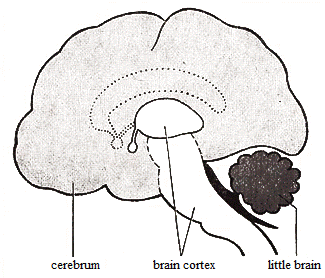
3.21 Overview of the brain parts
The central nervous system is connected by nerves with all parts of the body according to their duties. 12 pair of brain nerves and 31 pair of spinal cord nerves form the peripheral nervous system. Most of these nerves are mixed nerves, i.e., they consist of sensitive nerves which bring irritation from the sensory cells, and from the motor nerves which lead irritation to muscles or glands, so the peripheral nervous system is a connection of the central nervous system with the senses as well as with the muscles and glands of the head, neck, shoulder belt, limbs, back, chest wall and stomach wall.
The vegetative nervous system regulates the activity of the internal organs. It helps life processes to run without our will, for example respiration, digestion, blood circulation, secretion by the glands.
According to their functions, two parts can be distinguished in the vegetative nervous system which work as antagonists. For example, one part accelerates the activity of the heart, the other restrains it.
The reflex is a quick and unique reaction of the body to the irritation and the reaction goes without our will. Every reflex runs by a reflex curve, namely from irritable sensory cells through the reflex centre (in the brain or spinal cord) to a reactive organ.
There are inborn and acquired reflexes. The inborn reflexes are mostly preserved during the whole life. They regulate the behaviour of the living beings, e.g., with the food. Both animals and people have them, for example: inborn salivary reflex.
Food irritates the sensory cells of the tongue. By sensitive nerves irritation reaches the suitable reflex centre in the brain cortex. From there irritation comes through divergent nerves to the salivary glands which produce saliva as a reaction.
Other inborn reflexes are, e.g., the sucking reflex of the baby and the gulp reflex.
The acquired reflexes, unlike the inborn, are connected with the activity of the brain cortex. They must be learnt on the basis of innate reflexes. If they are not practiced then, they can be forgotten. They appear not only with the human, but also with higher developed animals.
The first acquired reflexes originate with the baby in connection with innate reflexes of the nutrients absorption. When seeing the milk bottle, for example, the salivary reflex appears because there is connection between the salivary reflex and the visual centre in the brain cortex.
The human reacts not only to the environmental irritation like a high developed animal, but also to written and spoken language. Only a human can anticipate the results of his action through mental activity, and establish the relations with nature and society. It distinguishes the human from other living beings.
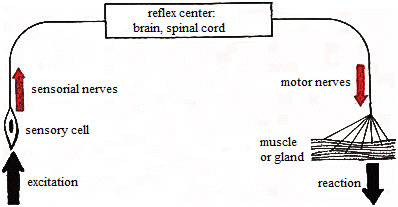
3.22 Course of a reflex curve (pattern)
1. Answer the questions using the information from the text.
1. What is a grey substance? Where is it?
2. What does the white substance of the nervous system consist of? Which function does it have?
3. What brain parts are distinguished? What is the brain stem?
4. How is the central nervous system protected?
5. Which processes are regulated in the brain cortex?
6. Which processes are regulated by the other brain parts?
7. Which nerves belong to the peripheral nervous system? Which functions do they have to fulfil?
8. Which functions does the vegetative nervous system have?
9. What is a reflex?
10. Which reflexes are formed only in the course of life?
2. Find in the text suitable contrasts and show them with different linguistic means
аdrenalin – …………………………………...
grey substance –
sensitive nerve –
innate reflex –
external secretion –
3. Form questions to the text with the help of the following verbs: be covered be based with, go out from, bring, be included in, have an effect on, stimulate to, play role with.
E.g.: consist of